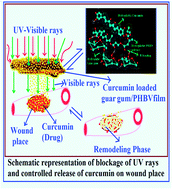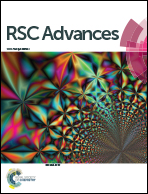Characterization and evaluation of curcumin loaded guar gum/polyhydroxyalkanoates blend films for wound healing applications†
Abstract
The present paper explores the ‘in situ’ fabrication of guar gum/polyhydroxyalkanoates-curcumin blend (GPCC) films in view of their increasing applications as wound dressings and antibacterial materials. Curcumin is incorporated to assess its bactericidal activity and to enhance the production and accumulation of the extracellular matrix in the healing process. In order to characterize the nature of the polymer network in the blend, FTIR/ATR spectra analysis and TGA are performed. The results reveal that the rigidity of the guar gum/PHBV blend improves with the increase of PHBV content due to the formation of non-covalent interactions, especially H-bonds, between these molecules. Electron microscopy analyses reveal the homogenecity of the blends and surface roughness of the blended films, favoring cell attachment and cell proliferation compared with the film without curcumin. The anti-microbial study demonstrate that the bactericidal activity is more effective against Gram-positive strains than Gram-negative strains. Results of the in vivo wound healing study in an animal model demonstrates that the developed curcumin loaded guar gum/PHBV blend film shows markedly enhanced wound healing compared to the control one.


 Please wait while we load your content...
Please wait while we load your content...